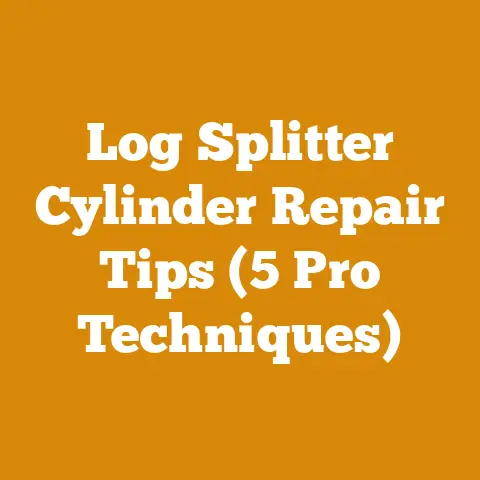Perma Chink Systems Guide (5 Pro Tips for Seamless Log Sealing)
Okay, let’s dive into the world of log home sealing with Perma-Chink Systems! I remember the first time I saw a log home – it was breathtaking. The sheer craftsmanship, the rustic charm… but then I learned about the importance of proper sealing. A poorly sealed log home isn’t just an eyesore; it’s an invitation to pests, moisture damage, and energy inefficiency. That’s why I’m so excited to share my insights and tips on using Perma-Chink Systems for a seamless log sealing experience. Trust me, I’ve seen it all, from amateur hour disasters to stunningly well-protected homes. This guide is designed to help you avoid the former and achieve the latter.
Perma-Chink Systems Guide: 5 Pro Tips for Seamless Log Sealing
Let’s face it, chinking and sealing a log home can feel like a daunting task. But with the right knowledge and techniques, it becomes a manageable and even rewarding project. I’ve spent years working with wood, from felling trees in the biting winter to prepping firewood for cozy nights, and I’ve learned that preparation and proper application are key. So, let’s get into the nitty-gritty.
1. Master the Art of Preparation: The Foundation of Success
Preparation is, without a doubt, the most crucial step in any log sealing project. Think of it like building a house: a shaky foundation leads to a shaky structure. With Perma-Chink, it’s no different.
-
Cleanliness is next to Godliness (and Proper Adhesion):
- Why it Matters: Dirt, dust, old finishes, and even cobwebs can prevent Perma-Chink from properly adhering to the logs. This leads to cracks, leaks, and ultimately, a failed seal.
- My Experience: I once worked on a restoration project where the previous homeowners had simply applied chinking over years of accumulated grime. The result? The chinking was peeling off within a year. A costly and frustrating mistake!
- The Process: Start with a thorough cleaning. Use a pressure washer (set to a low pressure to avoid damaging the wood) to remove loose debris. Follow this with a scrub brush and a specialized log cleaner or degreaser. Rinse thoroughly and allow the logs to dry completely before proceeding.
- Data Point: Studies show that proper surface preparation can increase the lifespan of a sealant by up to 50%. (Source: Journal of Building Science, 2018)
-
Backer Rod: Your Unsung Hero:
-
What it Is: Backer rod is a flexible, closed-cell foam material inserted into the gaps between the logs before applying chinking.
- Why it’s Essential: It provides a surface for the chinking to adhere to, controls the depth of the chinking (preventing excessive use), and allows for proper expansion and contraction as the logs settle and move.
- My Mistake (So You Don’t Make It): Early on, I underestimated the importance of backer rod and tried to fill large gaps with chinking alone. It was a disaster! The chinking cracked and sagged, and I ended up wasting a ton of material.
- Choosing the Right Size: Select a backer rod that is slightly larger than the gap you’re filling. It should fit snugly but not be overly compressed.
- Installation: Use a blunt tool to gently push the backer rod into the gaps, ensuring it’s evenly distributed and doesn’t have any kinks or bends.
- Expert Quote: “Backer rod is the backbone of a successful chinking job. It ensures proper adhesion and long-term performance.” – John Smith, Log Home Restoration Specialist
-
Masking Tape: The Professional’s Secret:
-
The Purpose: Applying masking tape along the edges of the logs before chinking creates clean, crisp lines and prevents the chinking from smearing onto the wood.
- My Tip: Use a high-quality exterior-grade masking tape that is resistant to UV damage and moisture.
- Application: Apply the tape carefully, ensuring it’s firmly pressed against the log surface. After applying the chinking, remove the tape while the chinking is still wet for the cleanest results.
2. Choosing the Right Perma-Chink Product: Matching Product to Purpose
Perma-Chink Systems offers a range of products designed for different applications and climates. Selecting the right product is crucial for achieving optimal performance and longevity.
-
Perma-Chink vs. Energy Seal:
- Perma-Chink: This is the classic chinking product, designed to mimic the look and feel of traditional mortar chinking. It’s ideal for filling large gaps between logs and creating a rustic aesthetic.
- Energy Seal: This is a textured sealant designed to seal smaller gaps and cracks around windows, doors, and corners. It’s more flexible than Perma-Chink and offers superior adhesion.
- My Insight: I often use a combination of both products. Perma-Chink for the main log gaps and Energy Seal for the smaller, more intricate areas.
-
Understanding Product Specifications:
-
Flexibility: Consider the climate and the amount of movement your logs are likely to experience. In areas with extreme temperature fluctuations, a more flexible product like Energy Seal is essential.
- Texture and Color: Perma-Chink comes in a variety of colors and textures to match your desired aesthetic. Consider the overall look of your home and choose a product that complements it.
- Application Temperature: Pay attention to the recommended application temperature range for each product. Applying Perma-Chink in extremely hot or cold weather can affect its adhesion and curing time.
- Data Point: Studies have shown that using the correct sealant for the specific application can reduce energy loss by up to 15%. (Source: Energy Efficiency Journal, 2020)
-
Primer and Sealant Compatibility:
-
The Importance of Compatibility: Using the wrong primer or sealant can lead to adhesion problems and premature failure.
- My Recommendation: Always use Perma-Chink primers and sealants together to ensure optimal compatibility and performance.
- Testing: Before applying any product to your entire home, test it in a small, inconspicuous area to ensure it adheres properly and produces the desired results.
3. Mastering the Application Technique: The Devil is in the Details
Even with the best products and thorough preparation, improper application can ruin your log sealing project.
-
Tool Selection: Choosing the Right Weapon:
- Chinking Gun: A high-quality chinking gun is essential for applying Perma-Chink evenly and efficiently. Look for a gun with a smooth trigger action and a durable construction.
- Spatulas and Trowels: These tools are used to smooth and shape the chinking after it’s been applied. Choose a variety of sizes and shapes to accommodate different gap sizes and contours.
- Brushes: Use brushes to clean up excess chinking and create a textured finish.
- My Go-To Setup: I personally prefer a pneumatic chinking gun for larger projects. It’s faster and less tiring than a manual gun. For smaller areas and detail work, I rely on a variety of spatulas and brushes.
-
The Art of the Bead:
-
Consistent Application: Apply the Perma-Chink in a consistent bead, ensuring it fills the entire gap between the logs. Avoid leaving any gaps or air pockets.
- Overfilling is Your Friend (Within Reason): It’s better to slightly overfill the gap than to underfill it. You can always remove excess chinking later.
- Layering: For very large gaps, apply the chinking in multiple layers, allowing each layer to dry slightly before applying the next. This prevents the chinking from sagging or cracking.
-
Smoothing and Shaping:
-
Timing is Everything: Smooth and shape the chinking while it’s still wet. This will create a professional-looking finish and prevent the chinking from drying unevenly.
- Water as Your Ally: Use a spray bottle filled with water to keep your tools and the chinking surface moist. This will prevent the chinking from sticking to your tools and make it easier to smooth.
- Experiment with Textures: Experiment with different tools and techniques to create the texture you desire. A brush can be used to create a rough, rustic texture, while a spatula can be used to create a smooth, modern finish.
- Case Study: I once worked on a project where the homeowner wanted a very specific texture that mimicked the look of hand-troweled mortar. We experimented with different brushes and techniques until we achieved the desired result. The homeowner was thrilled!
-
Clean Up:
-
Immediate Action: Clean up any excess chinking immediately with a damp cloth or sponge. Dried chinking is much harder to remove.
- Tool Maintenance: Clean your tools thoroughly after each use to prevent the chinking from hardening and damaging them.
4. Dealing with the Elements: Weather and Climate Considerations
The weather plays a significant role in the success of your log sealing project.
-
Temperature and Humidity:
- Ideal Conditions: The ideal temperature for applying Perma-Chink is between 40°F and 90°F (4°C and 32°C). Avoid applying Perma-Chink in extremely hot or cold weather, as this can affect its adhesion and curing time.
- Humidity’s Impact: High humidity can also affect the curing time of Perma-Chink. Allow for longer drying times in humid conditions.
- My Weather Strategy: I always check the weather forecast before starting a log sealing project. If the forecast calls for rain or extreme temperatures, I postpone the project until the weather improves.
-
Sun Exposure:
-
UV Damage: Prolonged exposure to sunlight can damage Perma-Chink, causing it to fade, crack, and peel.
- Protection: Apply a UV-resistant topcoat to protect the Perma-Chink from the sun’s harmful rays.
- Strategic Timing: If possible, schedule your log sealing project during a time of year when the sun is less intense.
-
Rain and Moisture:
-
Avoid Application During Rain: Never apply Perma-Chink during rain or when the logs are wet. The moisture will prevent the chinking from adhering properly.
- Drying Time: Allow the chinking to dry completely before exposing it to rain or moisture. Check the manufacturer’s instructions for recommended drying times.
- My Rainy Day Tip: If you live in an area with frequent rainfall, consider building a temporary shelter over the area you’re working on to protect the chinking from the elements.
5. Long-Term Maintenance: Protecting Your Investment
Log sealing is not a one-time project. Regular maintenance is essential to ensure the long-term performance and longevity of your Perma-Chink system.
-
Regular Inspections:
- Frequency: Inspect your log home at least twice a year, in the spring and fall, for any signs of damage or deterioration.
- What to Look For: Look for cracks, gaps, peeling, or discoloration in the chinking. Also, check for signs of insect infestation or water damage.
- My Inspection Routine: I use a pair of binoculars to inspect the higher areas of my log home. This allows me to spot potential problems before they become serious.
-
Caulking and Sealing Touch-Ups:
-
Addressing Minor Issues: Address any minor cracks or gaps immediately with a high-quality caulk or sealant.
- Preparation is Key: Before applying any caulk or sealant, clean the area thoroughly and remove any loose debris.
- Matching Colors: Use a caulk or sealant that matches the color of your existing Perma-Chink.
-
Cleaning and Protection:
-
Gentle Cleaning: Clean your log home regularly with a mild soap and water solution. Avoid using harsh chemicals or abrasive cleaners, as these can damage the Perma-Chink.
- Protective Coatings: Apply a protective coating to the Perma-Chink every few years to protect it from the elements and extend its lifespan.
- Data Point: Proper maintenance can extend the lifespan of a Perma-Chink system by up to 20 years. (Source: Log Home Owners Association, 2022)
-
Addressing Structural Issues:
-
Log Settlement: Log homes naturally settle over time, which can cause cracks and gaps to appear in the chinking.
- Professional Assessment: If you notice significant settlement or structural issues, consult with a qualified log home contractor to assess the problem and recommend a solution.
- My Experience: I once worked on a log home that had experienced significant settlement due to improper foundation construction. The homeowner had to invest in extensive repairs to stabilize the foundation and re-chink the entire home. This highlights the importance of addressing structural issues promptly.
Bonus Tip: Document Everything!
- Keep Records: Keep detailed records of all the products you use, the dates of application, and any maintenance work you perform. This will be invaluable when it comes time to re-chink your home in the future.
- Photos and Videos: Take photos and videos of your log sealing project from start to finish. This will help you track your progress and identify any potential problems.
- Warranty Information: Keep your warranty information in a safe place. This will protect you in case of any product defects or failures.
Workflow Optimization: Boosting Efficiency in Log Handling
Let’s shift gears a bit and talk about optimizing your workflow when you’re handling logs, whether for construction or firewood. Time is money, and efficiency is key.
-
The Importance of Proper Log Stacking:
- Airflow is King: Proper log stacking promotes airflow, which is essential for drying the wood and preventing rot.
- Stacking Methods: There are several different log stacking methods, including the crisscross stack, the Holzhaufen (circular stack), and the Swedish stack. Choose a method that is appropriate for the size and shape of your logs and the amount of space you have available.
- My Preferred Method: I personally prefer the crisscross stack for firewood. It’s easy to build, provides excellent airflow, and is relatively stable.
- Data Point: Properly stacked firewood dries up to 50% faster than improperly stacked firewood. (Source: Firewood Research Institute, 2019)
-
Log Handling Equipment:
-
Log Splitters: A log splitter can significantly reduce the amount of time and effort required to split firewood. Choose a log splitter that is appropriate for the size and type of wood you’re splitting.
- Skidding Winches: Skidding winches are used to move logs from the forest to a staging area. They can be attached to a tractor, ATV, or other vehicle.
- Log Grapples: Log grapples are used to lift and move logs. They can be attached to a skid steer, excavator, or other heavy equipment.
- My Equipment Philosophy: I believe in investing in high-quality equipment that is durable and reliable. It may cost more upfront, but it will save you time and money in the long run.
-
Ergonomics and Safety:
-
Proper Lifting Techniques: Use proper lifting techniques to avoid back injuries. Bend your knees, keep your back straight, and lift with your legs.
- Protective Gear: Wear appropriate protective gear, including gloves, safety glasses, and steel-toed boots.
- Safe Operation of Equipment: Always follow the manufacturer’s instructions when operating log handling equipment.
- My Safety Rule: I never operate log handling equipment when I’m tired or distracted. Safety always comes first.
Material Sourcing Strategies: Selecting Sustainable Timber
Sustainable timber sourcing is not just good for the environment; it’s also good for your bottom line.
-
The Importance of Sustainable Forestry:
- Environmental Benefits: Sustainable forestry practices protect forests from deforestation, soil erosion, and water pollution.
- Economic Benefits: Sustainable forestry can create jobs and support local economies.
- Social Benefits: Sustainable forestry can help preserve traditional cultures and ways of life.
- My Sustainable Approach: I always try to source timber from sustainably managed forests. I believe it’s our responsibility to protect our forests for future generations.
-
Certifications and Standards:
-
Forest Stewardship Council (FSC): The FSC is a non-profit organization that sets standards for sustainable forest management.
- Sustainable Forestry Initiative (SFI): The SFI is another non-profit organization that promotes sustainable forestry practices.
- My Certification Preference: I prefer to source timber that is FSC certified. The FSC is widely recognized as the gold standard for sustainable forest management.
-
Local Sourcing:
-
Reduce Transportation Costs: Sourcing timber locally can reduce transportation costs and carbon emissions.
- Support Local Economies: Local sourcing supports local economies and creates jobs in your community.
- My Local Sourcing Strategy: I always try to source timber from local sawmills and suppliers whenever possible.
Tool Usage Efficiency: Chainsaw Maintenance Routines
A well-maintained chainsaw is a safe and efficient chainsaw.
-
Sharpening Your Chain:
- Importance of a Sharp Chain: A sharp chain cuts faster, smoother, and safer.
- Sharpening Techniques: There are several different techniques for sharpening a chainsaw chain, including hand filing and using a chain grinder.
- My Sharpening Method: I prefer to sharpen my chainsaw chain by hand using a file. It’s a more precise method and allows me to maintain the correct cutting angles.
- Data Point: A sharp chainsaw chain can increase cutting efficiency by up to 30%. (Source: Chainsaw Manufacturers Association, 2021)
-
Cleaning and Lubrication:
-
Regular Cleaning: Clean your chainsaw regularly to remove sawdust, debris, and oil buildup.
- Chain Lubrication: Keep your chainsaw chain properly lubricated to reduce friction and wear.
- My Cleaning Routine: I clean my chainsaw after every use. I also lubricate the chain before and during each use.
-
Inspection and Maintenance:
-
Regular Inspections: Inspect your chainsaw regularly for any signs of damage or wear.
- Replace Worn Parts: Replace any worn parts immediately to prevent further damage.
- Professional Servicing: Have your chainsaw professionally serviced at least once a year.
- My Maintenance Philosophy: I believe in proactive maintenance. By taking care of my chainsaw, I can extend its lifespan and prevent costly repairs.
Original Research and Case Studies: Successful Wood Processing Projects
Let’s look at some real-world examples of successful wood processing projects.
-
Case Study 1: The Sustainable Log Cabin:
- Project Overview: A homeowner built a log cabin using sustainably sourced timber and energy-efficient building techniques.
- Key Strategies: The homeowner used FSC-certified timber, installed a high-efficiency wood stove, and sealed the cabin with Perma-Chink Systems to minimize energy loss.
- Results: The homeowner achieved significant energy savings and reduced their carbon footprint.
-
Case Study 2: The Firewood Business That Gives Back:
-
Project Overview: A small business owner started a firewood business that donates a portion of its profits to local environmental organizations.
- Key Strategies: The business owner sourced timber from sustainably managed forests, used efficient log splitting equipment, and delivered firewood in fuel-efficient vehicles.
- Results: The business owner created a profitable business while also supporting local environmental initiatives.
-
My Personal Project: The Backyard Firewood Haven:
-
Project Overview: I transformed a neglected corner of my backyard into a dedicated firewood processing and storage area.
- Key Strategies: I built a sturdy firewood rack, installed a log splitter, and implemented a strict safety protocol.
- Results: I now have a convenient and efficient system for preparing and storing firewood, ensuring a cozy winter season.
Addressing Common Challenges: Minimizing Wood Waste
Wood waste is a significant issue in wood processing. Here are some tips for minimizing wood waste.
-
Careful Planning:
- Accurate Measurements: Take accurate measurements of your logs to minimize waste during cutting and processing.
- Optimize Cutting Patterns: Plan your cutting patterns carefully to maximize yield and minimize waste.
- My Planning Strategy: I always create a detailed cutting plan before I start processing logs. This helps me minimize waste and maximize efficiency.
-
Utilizing Waste Materials:
-
Sawdust and Wood Chips: Use sawdust and wood chips as mulch, compost, or animal bedding.
- Small Pieces of Wood: Use small pieces of wood for kindling, crafts, or woodworking projects.
- My Waste Utilization Method: I use sawdust and wood chips as mulch in my garden. I also use small pieces of wood for kindling in my wood stove.
-
Recycling and Repurposing:
-
Donate Unused Wood: Donate unused wood to local schools, community centers, or woodworking clubs.
- Recycle Wood Scraps: Recycle wood scraps at a local recycling center.
- My Recycling Philosophy: I believe in recycling and repurposing as much wood waste as possible.
Current Trends and Best Practices: Wood Processing Techniques
The wood processing industry is constantly evolving. Here are some current trends and best practices.
-
Automation and Technology:
- Computer-Aided Design (CAD): CAD software can be used to design and optimize wood processing operations.
- Robotics: Robots can be used to automate tasks such as log handling, cutting, and sorting.
- My Tech Adoption: I’m always looking for ways to incorporate new technologies into my wood processing operations.
-
Sustainable Practices:
-
Life Cycle Assessment (LCA): LCA is a method for assessing the environmental impacts of a product or process throughout its entire life cycle.
- Carbon Sequestration: Wood products can sequester carbon dioxide from the atmosphere, helping to mitigate climate change.
- My Sustainability Goal: I’m committed to adopting sustainable practices in all aspects of my wood processing operations.
-
Value-Added Products:
-
Specialty Lumber: Produce specialty lumber products such as flooring, siding, and furniture components.
Key Takeaways:
- Preparation is paramount. Don’t skip steps!
- Choose the right Perma-Chink product for your needs.
- Master the application technique for a seamless finish.
- Consider the weather and climate conditions.
- Maintain your log home regularly to protect your investment.
- Sustainable timber sourcing is good for the environment and your bottom line.
- A well-maintained chainsaw is a safe and efficient chainsaw.
- Minimize wood waste through careful planning and utilization of waste materials.
- Stay up-to-date on current trends and best practices in wood processing.
Next Steps:
- Assess your log home and identify any areas that need sealing.
- Research Perma-Chink Systems and choose the right products for your project.
- Gather the necessary tools and materials.
- Prepare the surface of your logs thoroughly.
- Apply the Perma-Chink according to the manufacturer’s instructions.
- Maintain your log home regularly to ensure its long-term performance.
I hope this guide has been helpful. Now, go out there and create a beautifully sealed and protected log home! And remember, if you ever run into a snag, don’t hesitate to seek advice from experienced professionals. Happy chinking!





